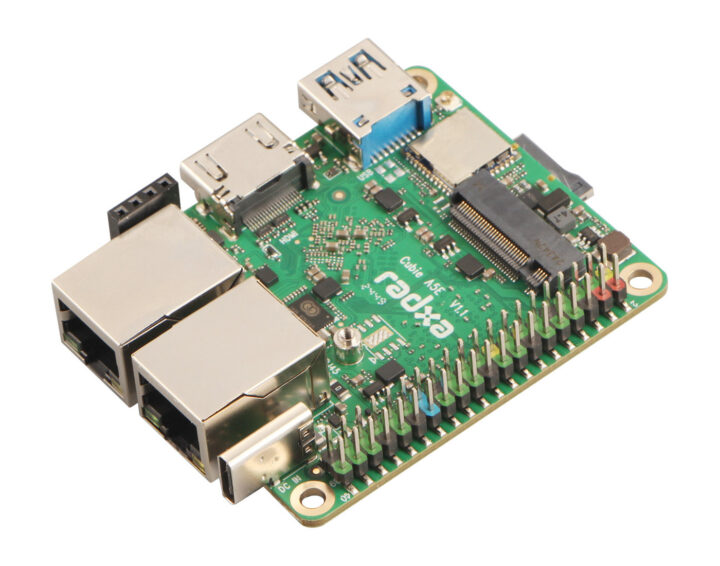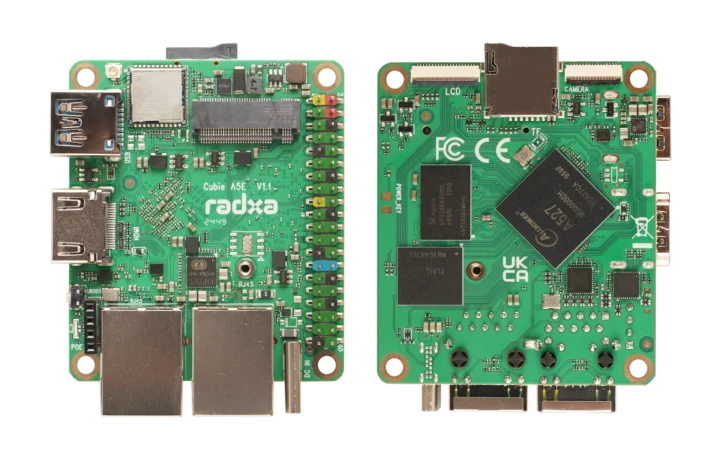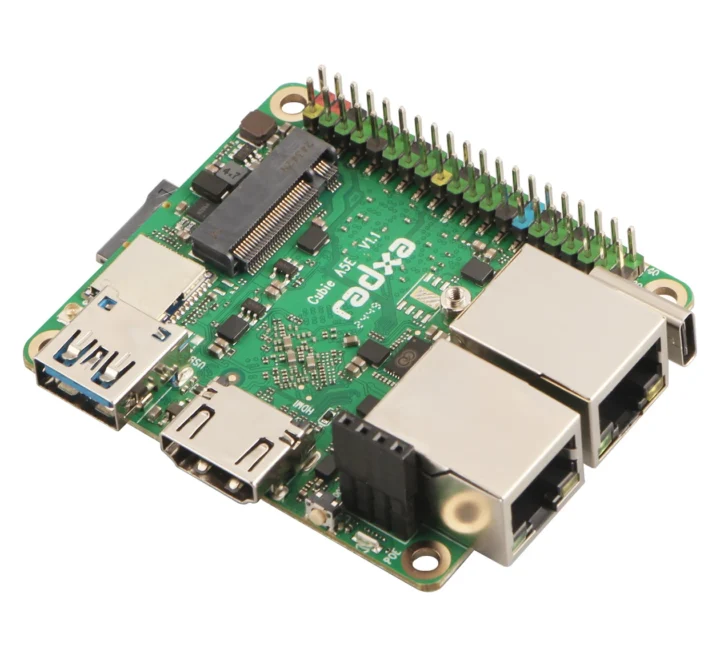Radxa Cubie A5E is an SBC powered by Allwinner A527/T527 octa-core Cortex-A55 SoC and featuring HDMI 2.0, dual GbE, WiFi 6 and Bluetooth 5.4, an M.2 socket for NVMe SSD, USB 3.0 Type-A and USB 2.0 OTG (Type-C) ports, and a 40-pin GPIO form factor in a compact 69x56mm form factor.
Long-time readers may remember the Allwinner A10-powered Cubieboard launched in 2012 as an alternative to the hard-to-get Raspberry Pi development board or the various TV boxes like the MeLE A1000 we tried to use to run Linux on Arm hardware. At the time, Allwinner SoCs became popular in SBCs but the company management eventually failed to deliver on software, so some members of CubieTech decided to split and founded Radxa to design Rockchip SBCs that looked more promising in terms of software support. It eventually ended up being a good move after a few difficult first years. However, Allwinner management has now changed and they’ve hired a team dedicated to open-source software, and that’s why Radxa has decided to launch its first Allwinner SBC with the Cubie A5E.
Cubie A5E specifications:
- SoC – Allwinner T527 (industrial) / Allwinner A527 (commercial)
- CPU
- Octa-core Arm Cortex-A55 processor with four cores @ 1.80 GHz (T527) or 2.0 GHz (A527) and four cores @ 1.42GHz
- XuanTie E906 RISC-V core up to 200 MHz
- GPU – Arm Mali-G57 MC1 GPU with support for OpenGL ES 3.2/2.0/1.1, Vulkan 1.1/1.2/1.3, OpenCL 2.2
- DSP – 600MHz HIFI4 Audio DSP
- AI accelerator – Optional, up to 2 TOPS NPU
- CPU
- System Memory – 1GB, 2GB, or 4GB LPDDR4 @ 2400 MT/s
- Storage
- 128Mbit SPI flash for bootloader
- M.2 M-Key 2230 socket for NVMe SSD
- MicroSD card slot
- Display interfaces
- HDMI 2.0a port
- MIPI FPC connector
- Camera interface – 4-lane MIPI CSI interface
- Networking
- 2x Gigabit Ethernet RJ45 ports using Maxio MAE0621A transceivers, one PoE compatible
- Dual-band WiFi 6 and Bluetooth 5.4 module (BLink BL-M8800DS2)
- USB – 1x USB 3.0 port, 1x USB 2.0 OTG Type-C port
- Expansion – 40-pin GPIO header (loosely) compatible with Raspberry Pi GPIO header and offering additional interfaces through muxing: up to 28x GPIO, 4x I2C, HDMI I2C, 6x UART (Debug UART0 on pin 8/10), multiple I2S inputs and outputs, DMIC, multiple PWM, etc…
- Misc
- FEL button
- 2x user LEDs
- Power Supply – 5V/4A via USB-C connector
- Dimensions – 69 x 56 mm
The specifications are very similar to the Avaota A1 open-source hardware SBC introduced last year, but the Radxa Allwinner A527/T527 SBC is offered in a smaller form factor and adds M.2 NVMe SSD support. However, it lacks DisplayPort video output, a 3.5mm audio jack, and a “multi-function” connector.
The board will run Linux, but there’s virtually no information about software support on the linux-sunxi website, just some hardware information. The product page for the Cubie A5E is not up on the Radxa website at this time either. But for reference, the Avaota A1 board runs the Debian or Ubuntu-based AvaotaOS, so it could serve as a base to get started on the new Radxa board. Eventually, the goal should be to get the Cubie A5E supported in mainline Linux. The Allwinner A527 and T527 are part of the sun55iw3 family like the Allwinner A523, and I don’t see any reference to the kernel logs for now, so there could be a lot of work…
The Radxa Cubie A5E SBC can be pre-ordered on Arace for $15 to $30 with 1GB, 2GB, or 4GB of RAM. Members of the linux-sunxi mailing list as of December 31, 2024, can request a free sample by filling out a form. Samples will be shipped before the Chinese New Year holiday, or in other words before the end of this month. While an octa-core Cortex-A55 may not be super exciting, it’s a stepping stone for more powerful boards down the roadmap powered by Allwinner A733 octa-core Cortex-A76/A55 AI SoC, and eventually Allwinner A838 octa-core Cortex-A78/A55 SoC (likely a 2026 story for that one).

Jean-Luc started CNX Software in 2010 as a part-time endeavor, before quitting his job as a software engineering manager, and starting to write daily news, and reviews full time later in 2011.
Support CNX Software! Donate via cryptocurrencies, become a Patron on Patreon, or purchase goods on Amazon or Aliexpress








Regarding the software, there is on-going effort from Andre [1], [2] and [3] for the initial support in the upstream kernel. I will be picking the display and PCIe support for A523 after display works for A133 [4].
Mainline status matrix can be watched here [5].
Also to add, Shenzhen Baijie Technology developed board with A523 [6] and A133 [7]. They have an upcoming Helperboard for A733 as well.
[1]: https://lore.kernel.org/linux-sunxi/20241111004722.10130-1-andre.przywara@arm.com/
[2]: https://lore.kernel.org/linux-sunxi/20241111005750.13071-1-andre.przywara@arm.com/
[3]: https://lore.kernel.org/linux-sunxi/20241111174225.7360c6e4@donnerap.manchester.arm.com/
[4]: https://lore.kernel.org/linux-sunxi/ed2ed7da-8c01-41c5-8215-d07892da3596@linumiz.com/
[5]: https://linux-sunxi.org/Linux_mainlining_effort#Status_Matrix
[6]: http://down.szbaijie.com:8088/helpera523/v1.7/
[7]: http://down.szbaijie.com:8088/helpera133/
TomCubie
Where is the OPEN source and documentation for the boot0 / DRAM and Video decoder (Cedar) ?
CLOSED binaries? GPL violations?
Are you LYING about Open Source?
Linux-Sunxi community is working on support by reverse engineering with ZERO help from Radxa and Allwinner!
For his defense, Tom didn’t say everything is already opensource, he said that Allwinner has dedicated a new team to opensource and that they’re going to work together. Thus I guess it will take some time before some code becomes available. But we cannot condemn the intent nor the efforts.
It seems you’re unaware that I was the one who made the first Allwinner boot0/DRAM code open source. If you take the time to read the article carefully and understand it, you’ll realize that Radxa has had no historical involvement with Allwinner until now.
Radxa’s decision to work with Allwinner is part of a broader effort to change the status quo, support the sunxi community, and expand our options beyond relying solely on Rockchip. This move benefits both the sunxi community and Radxa itself, fostering competition and innovation in the SBC landscape.
Another interesting fact – Cubietruck was the first device supported by seeds of Armbian projected, 11 years ago 😉 https://github.com/igorpecovnik/Cubietruck-Debian/tree/master #ancient
At what place can we follow the progress on Linux support ?
Nice try Mr. Cubie 🙂
Where is the open source code and docs for THIS board *Radxa Cubie A5E* and its SoC?
How will sunxi community be supported exactly?
Do you know sunxi best devs are hard at work now?
Please go see the last few weeks of the irclog:
https://oftc.irclog.whitequark.org/linux-sunxi
Thank you. Good luck.
Cheapest SBC compatible with an NVMe SSD?
Could’ve been a great home assistant machine if not for the lack of emmc storage. I understand that it supports nvme which should be better but home assistant doesn’t support it yet.
Either way, it seems like a great alternative to Orange Pi Zero 3 and Radxa E20C.
Doing a 10 second Google search actually reveals users having HA installations with NVMe SSDs.
Do you have any links claiming something different?
Last I checked the *official* HA Yellow had a NVMe slot…
I have a Green here for playing around, tempted to get something with NVMe (that emmc on the Green scares me) but leaning toward n100 for easier support.
There’s definitely a lot to like about this hardware. My typical focus is security, and so I look at this in terms of interception of communications. This supports three different standards – USB (UDC and Host ports), Ethernet (using Duckwall’s “A bridge to far” technique), as well as (optionally) HDMI – just add a readily available HDMI-CSI2 input adapter, and emit via the HDMI2 port.
On top of that, it has a WiFi interface for remote configuration and operation.
I’d be very interested to see what peripherals are accessible via the 40-pin expansion as well, beyond the usual Raspberry Pi compatability. Another USB interface, perhaps?
And finally, this is dirt cheap, compared to my usual Nano Pi R1S that I have so far settled on, and scales up to significantly more RAM and storage (even nVME!), although that may prevent operation from a PC USB port due to too much current draw, and may require a power/data splitter to function reliably.
LOL! Checked out the 40-pin header description on the sunxi page. Only 1 pin of USB2 is present, so no USB expansion possible. Whoops!
Thanks for reporting this, it’s fixed now. The USB signals on the PIN#27/#28 of the 40-pin GPIO header require either a specific SKU or a hardware modification (bridging the 0 Ω resistor). By default, those pins function as I²C.
Oh awesome! Will this fix ship with the first batch preordered from Arace? I have a 4GB on the way already!
lol! Less awesome. Seems the fix was to remove the solitary usb pin alt-mode from the docs! Ah well!
One more detail might be worth noting:
> M.2 M Key is muxed with USB 3.0, can be switched by GPIO.
@Tom Cubie
@newAllwinnerManagement
Could you as the ‘new’ team first start to resolve the issues the old management created? This would show that you really want to change something to the good and not just fake things again.
Start with releasing the full source code from back then when you got cought violating GPL. The code you release now should fit the Reproducible builds idea. I should be able to create with just free code the same file with same sha256sum from back then.
At second try to be at least as good as NXP and push on your own hardware to mainline/upstream with allwinnertech dot com email adresses.
Lets see if you really want to change something by doing at start those two basic things to not be this Alllooser company any more. I tell since many years to all people that they should avoid you. At every Hardware conference when i see Allwinner hardware on some table i explain the company workers about their bad SoC choise. I am happy to announce that there were already SoC manufacturer changes in some of those companies i talked to thanks to such personal talks at conferences and staying in contact later on to make sure they really get rid of Alllooser SoC’s in their products.
Reproducible builds are a super complex task that goes way further than opensource. It involves adaptations of toolchains and can even go against some build settings in projects themselves. While they’re a laudable goal, that’s typically off-putting for many people who genuinely try to contribute to opensource in good faith.
Similarly, wasting time on trying to fix predecessors’ mistakes doesn’t make much sense. It’s like asking someone to resurrect a victim of a previous killer. What matters is what will be done. As long as the hardware docs and the code for supported stuff are entirely provided so that there’s no need for reverse-engineering, that’s fine.
This is a dirt-cheap performant SBC.
You get an NXP and pay for the hardware *and* software support. Little fuss.
You pay for contemporary hardware at steep discount and you’re the support, not the community nor the company.
At some point people have been spoilt by FOSS — just because it’s fun to contribute and share for a lot of specialists devoting their free time.
The only fix here is to start paying developers.
@Willy
Reproducible builds should be there for the GPL-violation part this SoC company got famous for. Not for everything.
@Xander
There was a developer who got payed by Allwinner to do GPL-violations. Its paying people to do bad and not good. The code that violated GPL should never had been written.
Producing Hardware and not a single line of code would never had caused the GPL violation issue!
The USB 3 port on Allwinner is surprising to me. Because I remember boards with H3 or H5 without it.
> The USB 3 port on Allwinner is surprising to me.
The H6 already had USB3 / Superspeed. And that chip was released 7,5 years ago.
Or A80 with USB3 10+ years ago?
USB is one of the most messed up parts of Allwinner SoC.
On A527/T527 is USB3 or PCIe but not both at the same time?
Add 10 to 15 usd for shipping.
The old Radxa trick.
Hey 4 months later, can I comment on the Open Source progress,
without being censored, because Radxa is paying/advertising here?